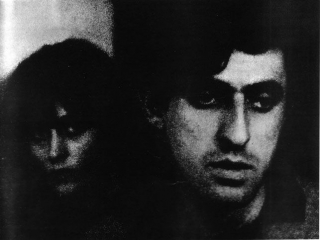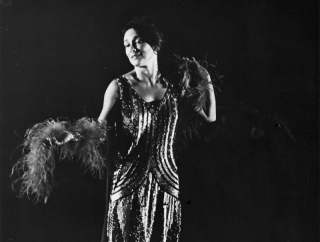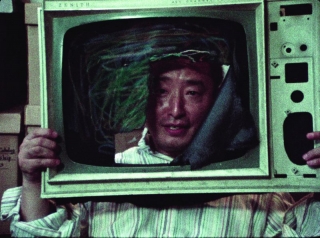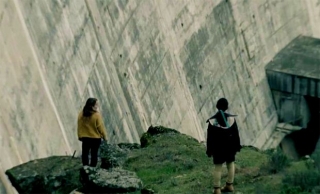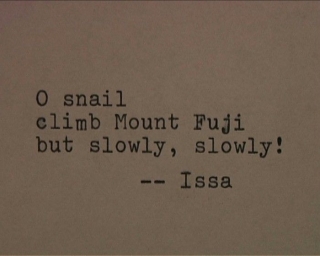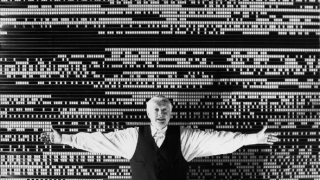Date: 27 September 2011 | Season: Plenty
PLENTY 11: ECHOES OF SILENCE
Tuesday 27 September 2011, at 7pm
London E:vent Gallery
The screening series PLENTY proposes a new way of looking at artists’ films by showing only a single work, regardless of its duration. Each film is given the freedom to unfold on its own terms, and the viewer is given the time and space to consider it.
ECHOES OF SILENCE
Peter Emanuel Goldman, USA, 1965, b/w, sound, 75 min
Echoes of Silence chronicles days of angst and languor for three young drifters amid the streets and tenements of Greenwich Village. There is a darkness. Desperate moments, futile liaisons, and the solitude of the big city are conjured in this grainy elegy to existential longing.
“Peter Goldman is the most exciting new filmmaker in recent years. Echoes of Silence, his first film, is a stunning piece of work.” (Susan Sontag)
With his early films, Peter Emanuel Goldman (born 1939) was acclaimed as an independent talent who bridged the gap between the American underground and French New Wave. He recently revisited this period of his life in the novel “Echoes on a Crying Floor”.
PLENTY, a free monthly screening series selected by Mark Webber, forms part of the “Brief Habits” programme curated by Shama Khanna.
NB: This screening was cancelled due to the sudden unavailabity of the film print.
Date: 21 October 2011 | Season: London Film Festival 2011 | Tags: London Film Festival
THE BFI 55th LONDON FILM FESTIVAL
21—24 October 2011
London BFI Southbank
The Experimenta Weekend is the London Film Festival’s annual survey of artist’s film and video. Over four days, from 21-24 October 2011, a unique sequence of programmes will offer a curated selection of outstanding work made around the world.
Phil Solomon, renowned for his exquisite 16mm films, will make his first appearance in the UK to introduce the epic American Falls. In a triptych of images, waves of chemically treated celluloid reflect the aspirations and tragedies of the American dream.
Two festival regulars return with debut features: Lewis Klahr’s elliptical narrative The Pettifogger further develops his distinctive cut-out animation techniques; Ben Rivers’ Two Years at Sea mixes fact and fantasy in an extended study of a marginal outsider. Observational filmmaker Robert Fenz and Portuguese artist Gabriel Abrantes are featured in solo screenings.
Contemporary moving image owes much to the pioneering generation of avant-garde filmmakers that appear in Pip Chodorov’s documentary Free Radicals. Jonas Mekas, a central figure in that movement’s history, will present two new works of his own: Sleepless Night Stories and Correspondence (in collaboration with José Luis Guerin). The visionary films of West Coast pioneer Chick Strand, which combine experimental, collage and ethnographic styles, can be rediscovered in newly preserved prints.
The Experimenta Weekend is curated by Mark Webber, with assistance from Adam Pugh and Marina Ribera.
Date: 21 October 2011 | Season: London Film Festival 2011 | Tags: London Film Festival
FREE RADICALS: A HISTORY OF EXPERIMENTAL CINEMA
Friday 21 October 2011, at 6:30pm
London BFI Southbank NFT3
Pip Chodorov, Free Radicals: A History of Experimental Cinema, France, 2010, 82 min
Free Radicals scratches the surface of the history of avant-garde cinema in Europe and the USA, from early post-war pioneers through to the founding of New York’s Anthology Film Archives, a museum whose screen is the exhibition space. Director Pip Chodorov is well-placed to chronicle the movement – he established the Re:Voir label to distribute tapes and DVDs of artists’ films, and counts many key exponents amongst his friends. In this personal journey through experimental movies, he surveys a generation of artists who pushed the boundaries of the medium. Working without compromise, and without financial rewards, they were forced to create their own support structures in an expression of solidarity. Whilst not claiming to be a definitive documentary, Free Radicals is a discerning introduction to the field, and its informal nature provides a privileged glimpse at the personalities involved. Archival footage of Hans Richter, Nam June Paik and Stan Vanderbeek (drawn from TV programmes made by the filmmaker’s father) supplements new interviews with Chodorov’s distinguished acquaintances (Jonas Mekas, Peter Kubelka, Ken Jacobs, Robert Breer) and generous excerpts from the films themselves. (Mark Webber)
Also Screening: Monday 24 October 2011, at 4:15pm, NFT3
& Monday 24 October 2011, at 7pm, BFI Studio
PROGRAMME NOTES
FREE RADICALS: A HISTORY OF EXPERIMENTAL CINEMA
Friday 21 October 2011, at 6:30pm
London BFI Southbank NFT3
FREE RADICALS: A HISTORY OF EXPERIMENTAL CINEMA
Pip Chodorov, France, 2010, video, colour, sound, 82 min
The artists and poets of cinema since before WWI have always been free radicals, crazy about filmmaking and pushing the art form in radical new directions. Trapped in a no man’s land, excluded both from the art world and the film industry, they boldly created a grassroots network for making and showing their films in a spirit of friendship and solidarity. They also created a profound body of work that continues to influence our culture. In this film, I want to share a few of the films I love and introduce you to some of the free, radical artists who made them. (Pip Chodorov)
Paris-based filmmaker and film activist Pip Chodorov offers this affectionate overview of some of the leading figures of, 20th century experimental film. Narrating in a personal and plainspoken manner (‘I’d like you to meet some of my friends and see their films’), Chodorov combines clips and even films in their entirety with conversations with such luminaries as Hans Richter, Robert Breer, Michael Snow, Peter Kubelka, and Stan Brakhage in his final recorded interview. The film takes its title from Len Lye’s direct animation classic. It was up to visionaries like Jonas Mekas and the organizations he founded – Film-Makers’ Cooperative, Anthology Film Archives – to help struggling filmmakers out. (At one point, Ken Jacobs describes dumpster diving for food.) Warm and inspiring, Chodorov’s film is part essay and part loving tribute. (AFI Film Festival)
Back to top
Date: 21 October 2011 | Season: London Film Festival 2011 | Tags: London Film Festival
TWO YEARS AT SEA
Friday 21 October 2011, at 9pm
London BFI Southbank NFT1
Ben Rivers, Two Years at Sea, UK, 2011, 88 min
Using old 16mm cameras, artist Ben Rivers, who has been nominated for the Jarman Prize and has won a Tiger Award at Rotterdam, creates work from stories of real people, often those who have disconnected from the normal world and taken themselves into wilderness territories. His new long-form work extends his relationship with Jake, a man first encountered in his short film This Is My Land. The title refers to the work Jake did in order to finance his chosen state of existence. He lives alone in a ramshackle house, in the middle of the forest. It’s full of curiosities from a bygone age, including a beloved old gramophone. We see his daily life across the seasons, as he occupies himself going for walks in all weathers, and taking naps in the misty fields and woods. Endlessly resourceful, he builds a raft to fish in a loch. Jake has a tremendous sense of purpose, however eccentric his behaviour seems to us. The presence of the camera is irrelevant to him; he has no desire for human contact, and is completely at home in his environment, the nature around him and his constructed abode. Rivers’ gracefully-constructed film creates an intimate connection with an individual who would otherwise be a complete outsider to us. (Helen de Witt)
Also Screening: Monday 24 October 2011, at 1:30pm, NFT1
PROGRAMME NOTES
TWO YEARS AT SEA
Friday 21 October 2011, at 9pm
London BFI Southbank NFT1
TWO YEARS AT SEA
Ben Rivers, UK, 2011, 35mm, b/w, sound, 88 min
Ben Rivers’ feature Two Years at Sea follows Jake Williams (also the subject of one of Rivers’ earlier short films) over the course of two years; a man living in complete isolation in a tumbledown home nestled amidst a magnificent forest, a self-imposed solitary exile from society and modernity. Free from dialogue or interaction with his subject, Rivers’ film makes no attempt to psychologise his subject’s Walden-esque existence, instead documenting over a series of long, often static shots the minutiae of Jake’s self-sufficient relationship to his environment.
Close-ups of weathered photographs offer glimpses of a former life equally in thrall to nature; one spent with friends or family members, now simply ghosts adrift in memory. We watch Jake wake and shower, fetch water and firewood, and in an extraordinary single shot build a raft from an inflatable mattress, taking to the water to fish. His existence is one seeming to grow out of as much as disappear into his surroundings, the ramshackle remnants of modern life which fill his home reconstituted to new purpose, the house itself slowly fusing itself to the landscape. Jake too, as in certain shots reflections of foliage in the windows of his campervan create an impression of the landscape enveloping him, consuming him as he rests.
This symbiosis of the organic and mechanical is beautifully captured by Rivers’ monochrome photography; shooting on reclaimed 16mm Bolex cameras, the shifting textures of the images have a makeshift feel, as though the camera were put together by Jake from parts found in one of his many junk-filled cupboards, the pops and crackles of his bonfire at the end mirrored by those of the celluloid, the flares and white-outs adding to the very fabric of the photographed scenery; the film itself acting on what its capturing.
The serenity of Jake’s gaze in the breathtaking final shot speaks more than an hour of interview footage could, it’s a privilege to be able spend ninety minutes in the company of such an extraordinary individual, one with seemingly no need for human interaction of any kind and it’s a measure of Rivers’ respectful directorial stance that his/our presence never feels intrusive. Much as when the camera looks out from the window of Jake’s observation-tower creation, over the silent, snow-capped forest, one can begin to understand his reason for being there; when it takes in Jake, gazing through the same window, one can equally understand Rivers’ reason too.
(Mathew Thrift, www.cinephile-uk.com)
I made a shorter film about Jake called This is My Land five years ago, and as time has passed and other films have been made, I have had a continual feeling that I should go back. The first film was based solely on observation; standing back and watching Jake go about his business in the forest. I wanted Two Years at Sea to move beyond this, so Jake and I worked on scenes that either re-enacted parts of his daily doings, or were fictions not far from his life. The film embraces the slower perception of time, following rhythms that Jake and his environment have, shot over the course of a year in all the seasons. Two Years at Sea has at its core the relationship between a person and the place they have chosen to live out their life, and the deep connection there is between them. Originally the film was going to be shot in colour, then Kodak announced they were discontinuing my favourite black and white film stock, which prompted me to buy as much as I could and make one of the last films with Kodak Plus-X. The film was hand developed in my kitchen. www.benrivers.com
(Ben Rivers)
Back to top
Date: 22 October 2011 | Season: London Film Festival 2011 | Tags: London Film Festival
ALTERED STATES
Saturday 22 October 2011, at 2pm
London BFI Southbank NFT3
Ben Russell, Trypps #7 (Badlands), USA, 2010, 10 min
The mirror crack’d: As a young woman, high on LSD, looks toward the camera, the doors of perception swing open for both viewer and subject.
Mary Helena Clark, While You Were Sleeping, USA, 2010, 9 min
‘This is your life. It rides like a dream.’ (MHC)
Neil Beloufa, Sans Titre, France, 2010, 15 min
In a reconstruction of a villa occupied by terrorists during the Algerian War, onlookers speculate on the activities that took place.
Emily Wardill, The Pips, UK, 2011, 4 min
A gymnast performs, and everything begins to fall away …
Deborah Stratman, … These Blazeing Starrs!. USA, 2011, 14 min
Watch the skies! Throughout history, comets have heralded events of grave significance and change; today it is thought that they can reveal facts about the formation of the universe.
Michael Robinson, These Hammers Don’t Hurt Us, USA, 2010, 13 min
‘Tired of underworld and overworld alike, Isis escorts her favourite son on their final curtain call down the Nile, leaving a neon wake of shattered tombs and sparkling sarcophagi.’ (MR)
Also Screening: Thursday 27 October 2011, at 3:45pm, NFT3
PROGRAMME NOTES
ALTERED STATES
Saturday 22 October 2011, at 2pm
London BFI Southbank NFT3
ALTERED STATES
TRYPPS #7 (BADLANDS)
Ben Russell, USA, 2010, video, colour, sound, 10 min
Trypps #7 (Badlands) charts, through an intimate long-take, a young woman’s LSD trip in the Badlands National Park before descending into a psychedelic, formal abstraction of the expansive desert landscape. Concerned with notions of the romantic sublime, phenomenological experience, and secular spiritualism, the work continues Russell’s unique investigation into the possibilities of cinema as a site for transcendence. (Michael Green)
www.dimeshow.com
WHILE YOU WERE SLEEPING
Mary Helena Clark, USA, video, colour, sound, 2010, 9 min
‘This is your life. It rides like a dream.’ (Mary Helena Clark)
SANS TITRE
Neil Beloufa, France, 2010, video, colour, sound, 15 min
A cardboard decor and photographs reconstitute a luxury Californian-type villa in Algeria. Its inhabitants, neighbours and other protagonists imagine themselves there to explain why and how the latter was occupied by terrorists in order to hide whilst, paradoxically, it is entirely in glass. They even polished it clean so as to leave no traces. This improbable and irresolvable anecdote encourages the characters to invent images of an event given media coverage without the images nor the story and thus missing the main point. (Neil Beloufa)
THE PIPS
Emily Wardill, UK, 2011, video, b/w, silent, 4 min
Emily Wardill’s films encourage imagination as an unpredictable tool to surpass rational thought. The Pips explores movement and the materiality of it, the instigation of one and the duration of the other. Shot in black and white on 16mm, then transferred to a digital projection, The Pips focuses on British gymnastics champion, Francesca Jones. The film begins with a straight depiction of Jones’ routine; the patterns created by her ribbon baton trace her movements in the air. It is a reflection of her actions, imitating her and existing because of her. Near the end of the film, the gymnast’s body becomes stretched, elongated and distorted ultimately breaking into a series of mutant parts. Her face remains unfathomed and she gives no acknowledgement to her own decay. As Jones becomes still, her actions take on their own identity; their materiality deconstructed by Wardill’s emphasis on the physical replication of movement. The body and its motions become contained in the object, revealing an inherent plasticity in the gymnast’s performance. (Ian White)
… THESE BLAZEING STARRS!
Deborah Stratman, USA, 2011, 16mm, b/w, sound, 14 min
Since comets have been recorded, they’ve augured catastrophe, messiahs, upheaval and end times. A short film about these meteoric ice-cored fireballs and their historic ties to divination that combines imagery of 15th-18th century European broadsides with NASA Jet Propulsion Laboratory footage. … These Blazeing Starrs! juxtaposes a modern empirical desire to probe and measure against older methods, when we translated the sky to predict human folly. These days, comets are understood as time capsules harbouring elemental information about the formation of our solar system. We smash rockets into them to read spectral signatures. In a sense, they remain oracles – it’s just the manner of divining which has changed. (Deborah Stratman)
www.pythagorasfilm.com
THESE HAMMERS DON’T HURT US
Michael Robinson, USA, 2010, video, colour, sound, 13 min
Looking to a future beyond death, Michael Robinson’s These Hammers Don’t Hurt Us, one of the filmmaker’s most sophisticated found footage concoctions yet, combines Michael Jackson’s Remember the Time music video with footage of Elizabeth Taylor in Cleopatra and roughly a dozen other sources, creating for the late pop star a solemn passage into a bedazzled Egyptian afterlife tenderly ushered by his real-life confidante. (Genevieve Yue, Reverse Shot)
www.poisonberries.net
Back to top
Date: 22 October 2011 | Season: London Film Festival 2011 | Tags: London Film Festival
NATHANIEL DORSKY / BEN RIVERS
Saturday 22 October 2011, at 4pm
London BFI Southbank NFT3
Nathaniel Dorsky, Pastourelle, USA, 2010, 17 min
‘A pastourelle and an aubade are two different forms of courtship songs from the troubadour tradition. In this case, the film Pastourelle, a sister film to Aubade, is in the more tumultuous key of spring.’ (ND)
Nathaniel Dorsky, The Return, USA, 2011, 27 min
‘Like a memory already gone, this place of life.’ Dorsky has created a poetic form of cinema in which the screen becomes a site for reverie or transfiguration. In his most recent film, he seems to move towards a more abstract representation of light and being.
Ben Rivers, Sack Barrow, UK, 2011, 21 min
The march of time claims another casualty. Sack Barrow documents (and laments) the out-dated, but functioning, technology of a family owned electroplating factory in the weeks around its closure – its old ways now unsustainable in the modern world.
Also Screening: Tuesday 25 October 2011, at 8:45pm, NFT2
PROGRAMME NOTES
NATHANIEL DORSKY / BEN RIVERS
Saturday 22 October 2011, at 4pm
London BFI Southbank NFT3
NATHANIEL DORSKY / BEN RIVERS
PASTOURELLE
Nathaniel Dorsky, USA, 2010, 16mm, colour, silent, 17 min
Though silent, like all Dorsky films, Aubade and Pastourelle are named for types of love songs. His editing establishes tempo, and the shots, lyrical yet specific, thread through the film like melody lines. Music owes its universality to its abstract and primal qualities, which evoke intense emotion. Dorsky’s films operate on the viewer in this manner while still relying on recognizable images. By presenting music visually, he enlarges our sense of what songs and films alike can be. In particular Dorsky is drawn to the ways in which one thing becomes a conduit for transmitting another. Window surfaces are a recurring motif: through reflection, panes of glass contain images while remaining transparent, transforming the appearances of people or street scenes. There’s a shot in Pastourelle of vertical blinds shading a window; a strand pivots on its axis, animated by a draft. It’s mundane and magical simultaneously, an inconsequential detail that contains everything that is meaningful about seeing and being. The blind and the breeze share an interconnectedness you feel in your bones. An explication can’t do it justice. The wonder lies in the fact that it simply is. (Nicole Armour, Film Comment)
www.nathanieldorsky.net
THE RETURN
Nathaniel Dorsky, USA, 2011, 16mm, colour, silent, 27 min
Nathaniel Dorsky, the subject of numerous recent international retrospectives, is producing some of the most resplendent art of our time; his film work stems as much from painting and poetry as the outside world. With The Return, his latest film shot on 16mm and projected at silent speed (18fps), Dorsky delves deep into multiple (under)worlds, sometimes uncanny and surreal, reflected and refracted through various natural and man-made obfuscations like grids, glass, water and brush. From its wintry willow branches to wafting hand gestures in a café, The Return harbours a phantasmal feel, offering a sentient, sometimes dark rumination
on the mysteries that await us. It is, in Dorsky’s words, ‘Like a memory already gone, this place of life’. (Andréa Picard, Toronto International Film Festival)
www.nathanieldorsky.net
SACK BARROW
Ben Rivers, UK, 2011, 16mm, b/w & colour, sound, 21 min
Sack Barrow extends Rivers’ engagement with the marginal and overlooked. The factory is not a state-of-the-art capital producing business, but a site of anachronistically uncompetitive endeavour. The years of production are evident and the regimented clocking in and out of workers attests to the outmoded practices here, unlike the liberal job-sharing egalitarianism that government policy and public expectation impose elsewhere. The run-down architecture, the drips and crusty build-ups of toxic chemicals, the dangling wires, wizened faces and the general pragmatic clutter of the place come close to the patina of the unkempt shacks of earlier films. Sack Barrow is a hymn in a new register to the steadily disappearing textures of the past. (Sally O’Reilly)
www.benrivers.com
Back to top
Date: 22 October 2011 | Season: London Film Festival 2011 | Tags: London Film Festival
GABRIEL ABRANTES
Saturday 22 October 2011, at 7pm
London BFI Southbank NFT3
Gabriel Abrantes & Benjamin Crotty, Liberdade, Portugal-Angola, 2011, 16 min
Liberdade sketches episodes in the relationship between a domineering Chinese immigrant and her Angolan boyfriend with lavishly cinematic panache. Travelling through spectacular locations in and around Luanda, they navigate the complications of their burgeoning identities and the different cultures they represent.
Gabriel Abrantes & Daniel Schmidt, Palácios de Pena (Palaces of Pity), Portugal, 2011, 56 min
Gabriel Abrantes and his collaborators use the tropes of mainstream cinema to make works that are by turns comical, thought-provoking and transgressive. In a parable on guilt and oppression, which alludes to aspects of Portuguese colonial history, two cousins are potential heirs to their grandmother’s fortune. A new generation may be oblivious to the past, but inherits it nonetheless.
Gabriel Abrantes & Katie Widloski, Olympia I & II, Portugal-USA, 2008, 7 min
Mimicking the composition of Manet’s notorious painting, the artists play out two possible scenarios: between a prostitute and her gay brother, and between a wealthy transsexual and his devoted maid.
Also Screening: Tuesday 25 October 2011, at 1:15pm, NFT2
PROGRAMME NOTES
GABRIEL ABRANTES
Saturday 22 October 2011, at 7pm
London BFI Southbank NFT3
LIBERDADE
Gabriel Abrantes & Benjamin Crotty, Portugal-Angola, 2011, video, colour, sound, 16 min
Shot in Luanda and the surrounding area, with non-professional actors, Liberdade is a cross-cultural post-capitalist love story. The film follows two young lovers – an Angolan boy, Liberdade, and his Chinese girlfriend, Betty – as they navigate through the complications of their burgeoning identities. Traveling across the stunning urban and natural landscapes of Angola, from the Chinese karaoke at Shanghai Bahia to the ship graveyard at Santiago beach, Liberdade and Betty struggle to forge the yet uncreated consciousness of their race. (Gabriel Abrantes)
PALÁCIOS DE PENA (PALACES OF PITY)
Gabriel Abrantes & Daniel Schmidt, Portugal, 2011, video, colour, sound, 56 min
Palácios de pena is about a culturally inherited fear in Portugal, linked to political and social oppression during the Inquisition and Fascism. It revolves around two upper-middle class adolescent Portuguese girls, juxtaposing their budding identities to a trial condemning two Moorish homosexuals to burn at the stake. Their ailing grandmother gives them an awareness of their heritage through the mechanism of desire, describing a dream where she is a judge of the Inquisition. The grandmother’s and the girls’ guilt is complicated by their relationship, that of family and love. As they love each other, so does what they represent: ignorance and the will to violently oppress. (Gabriel Abrantes)
OLYMPIA I & II
Gabriel Abrantes & Katie Widloski, Portugal-USA, 2008, video, colour, sound, 7 min
1. A female professional sex worker is visited by her homosexual adolescent brother and his two dogs. He confronts her about her line of work after having played trivial pursuit with mother on the sun deck. He wouldn’t pay a dime for her disgusting breasts.
2. A transvestite professional sex worker from a middle class Texan family waits for customers while listening to Henry Gorecki and drinking mini Diet Coca-Cola. His maid, the ‘chocolate covered strawberry’, comforts him by rubbing his ‘soft batch’ and they begin making love. (Gabriel Abrantes)
www.mutualrespectproductions.blogspot.com
Back to top
Date: 22 October 2011 | Season: London Film Festival 2011 | Tags: London Film Festival
SLEEPLESS NIGHTS STORIES
Saturday 22 October 2011, at 9pm
London BFI Southbank NFT3
Jonas Mekas, Sleepless Nights Stories, USA, 2011, 114 min
Jonas Mekas’ opening confession that he suffers from insomnia will come as no surprise to anyone aware of his singular contribution to cinema. Over 50 years he has established and promoted a viable culture for truly independent and avant-garde filmmaking, and his recent acceptance by the art world has brought a long overdue wave of attention and success. Sleepless Nights Stories is the latest in the series of long-form diary films that Mekas has been making since his arrival in the USA in 1949. Eating, drinking, singing and dancing with friends, the tireless octogenarian is full of life and wonder, casually weaving together contemporary folk tales collected during travels across the globe. Marina Abramovic fantasizes about domesticity, Lee Stringer recounts an episode from his crack-addicted past, and the protagonist toasts the ‘working class voice’ of Amy Winehouse. Marina Abramovic, Björk, Harmony Korine and Patti Smith also appear. Treating significant and inconsequential moments with equal import, Mekas’ modern day saga presents the first episodes from his ambitious ‘1001 Nights’ project. (Mark Webber)
Also Screening: Tuesday 18 October 2011, at 9pm, VUE3
& Thursday 20 October 2011, at 7pm, BFI Studio
PROGRAMME NOTES
SLEEPLESS NIGHTS STORIES
Saturday 22 October 2011, at 9pm
London BFI Southbank NFT3
SLEEPLESS NIGHTS STORIES
Jonas Mekas, USA, 2011, video, colour, sound, 114 min
For two hours we stroll with Jonas Mekas through New York nights, through apartments, studios, backstage rooms, galleries, bars and clubs. We meet old acquaintances like Ken and Flo Jacobs, Yoko Ono, Patti Smith, Carolee Schneemann, Marina Abramovi?, Hans Ulrich Obrist, Pip Chodorov, friends, brothers and sisters, sons and daughters, and we also make many new acquaintances. The father of the diary film begins a film with the words ‘I can’t sleep’. Who hasn’t been in this situation? Sleepy and yet wide awake at the same time, you find yourself in the world of those exhausted from the day’s exertions; the drunk, the relaxed, the dancing, the brooding, the mourning, the pensive, the partiers. In this film Mekas dives into a time vacuum … and it becomes increasingly unclear whether we really did get up and go out, whether what we’re seeing are remnants of the day that we’re remembering, or remnants of films by one of the greatest avant-garde filmmakers whose life wrote film history. (Berlinale)
This film originated from my readings of the One Thousand and One Nights. But unlike the Arabian tales, my stories are all from real life, though at times they too wander into somewhere else, beyond the everyday routine reality. There are some twenty-five different stories in my movie. Their protagonists are all my good friends and I myself am an inseparable part of the stories. The storyteller of the Arabian Nights was also part of his or her tales. Some of the people in the movie you’ll recognize, some not. The fact that some of them you’ll recognize has no bearing on the stories: after all, we all recognize John Wayne or Annette Bening, but in their stories they are no longer the people we know. The subjects of the stories cover a wide range of emotions, geographies, personal anxieties, anecdotes. These are not very big stories, not for the Big Screen: these are all personal big stories … And yes, you’ll also find some provocations … But that’s me, one ‘me’ of many. The very question ‘What is a story?’ is a provocative question. (Jonas Mekas)
www.jonasmekasfilms.com
Back to top
Date: 2 November 2011 | Season: Plenty | Tags: Peter Kubelka
PLENTY 12: DICHTUNG UND WAHRHEIT
Tuesday 2 November 2011, at 7pm
London E:vent Gallery
The screening series PLENTY proposes a new way of looking at artists’ films by showing only a single work, regardless of its duration. Each film is given the freedom to unfold on its own terms, and the viewer is given the time and space to consider it.
DICHTUNG UND WAHRHEIT (POETRY AND TRUTH)
Peter Kubelka, Austria, 2003, 16mm, colour, silent, 13 min
In cinema, as in anthropological study, the ready-made reveal ssome of the fundamental poetry and truth of our lives. Peter Kubelka unearthed sequences of discarded takes from advertising films and presents them, almost untouched, as documents that unwittingly offer valuable and humorous insights into the human condition.
“Peter Kubelka is the world’s greatest filmmaker – which is to say, simply: see his films! … by all means/above all else … et cetera.” (Stan Brakhage)
Peter Kubelka (born 1933) is an artist, anthropologist, cook and teacher. Active as a filmmaker over five decades, his total output amounts to some sixty-two minutes of screen time in which he explores the essential qualities of cinema.
PLENTY, a free monthly screening series selected by Mark Webber, forms part of the “Brief Habits” programme curated by Shama Khanna.
Date: 10 October 2012 | Season: London Film Festival 2012 | Tags: London Film Festival, Peter Kubelka
MONUMENT FILM INSTALLATION
Wednesday 10 – Sunday 21 October 2012
London BFI Southbank Atrium
Peter Kubelka, Monument Film, Austria, 2012, film installation
Kubelka first presented film as a three dimensional sculptural object in 1958. As an integral part of his new work Monument Film, the celluloid filmstrips of Arnulf Rainer (1960) and Antiphon (2012) will be exhibited on the walls of the Atrium at BFI Southbank, making manifest the relationship between space, time, and the physical material which runs through the projector.
Admission Free. Open from 12pm to 9pm daily.
